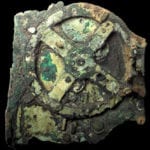 Religion
Religion  Religion
Religion  Weird Stuff
Weird Stuff 10 Horrifying Final Destination-Like Accidents
 Movies and TV
Movies and TV 10 Music Biopics That Actually Got It Right
 History
History 10 Momentous Events That Also Occurred on July 4th
 Animals
Animals 10 Times Desperate Animals Asked People for Help… and Got It
 Movies and TV
Movies and TV 10 Movie Flops That Found Their Way to Cult Classic Status
 History
History 10 Things You Never Knew About Presidential First Ladies
 Movies and TV
Movies and TV 10 Zombie Movies That Will Actually Terrify You
 Humans
Humans 10 Times Scientists Were Absolutely Sure… and Absolutely Wrong
 Our World
Our World 10 Pivotal Moments for Life on Earth
 Religion
Religion 10 Innovations and Discoveries Made by Monks
 Weird Stuff
Weird Stuff 10 Horrifying Final Destination-Like Accidents
 Movies and TV
Movies and TV 10 Music Biopics That Actually Got It Right
Who's Behind Listverse?

Jamie Frater
Head Editor
Jamie founded Listverse due to an insatiable desire to share fascinating, obscure, and bizarre facts. He has been a guest speaker on numerous national radio and television stations and is a five time published author.
More About Us History
History 10 Momentous Events That Also Occurred on July 4th
 Animals
Animals 10 Times Desperate Animals Asked People for Help… and Got It
 Movies and TV
Movies and TV 10 Movie Flops That Found Their Way to Cult Classic Status
 History
History 10 Things You Never Knew About Presidential First Ladies
 Movies and TV
Movies and TV 10 Zombie Movies That Will Actually Terrify You
 Humans
Humans 10 Times Scientists Were Absolutely Sure… and Absolutely Wrong
 Our World
Our World 10 Pivotal Moments for Life on Earth
Top 10 Ideas That Are Saving The World
The World Health Organization estimates that 75% of goods donated to the developing world goes unused. Why?
Well, usually the donated goods are either broken, too costly to maintain, don’t fit their new environment, or nobody knows how to use them. As one aid worker frustrated with piles of hearing aids ill-suited for the type of hearing loss found in Africa puts it, “…There’s been a lot of good will and bad judgment in the West. It’s like you need a spare tire for your Volkswagen and they sent a Mercedes radiator instead.”
As you may remember from the earlier 10 Cases of Appropriate Technology, the goal of AT is “to increase the standard of living for the developing world without condescension, complication, or environmental damage. Typical AT inventions are more labor intensive, require fewer resources, and use low cost or readily available materials wherever possible. Special attention is paid to the social, cultural, and ethical aspects of the communities the technology is intended for.”
Submitted for your approval are “10 More Cases of Appropriate Technology” – and you’ll find they’re every bit as clever as the latest iPad. You’ll also find links to organizations distributing these products for little or no cost, should you wish to contribute to their efforts.
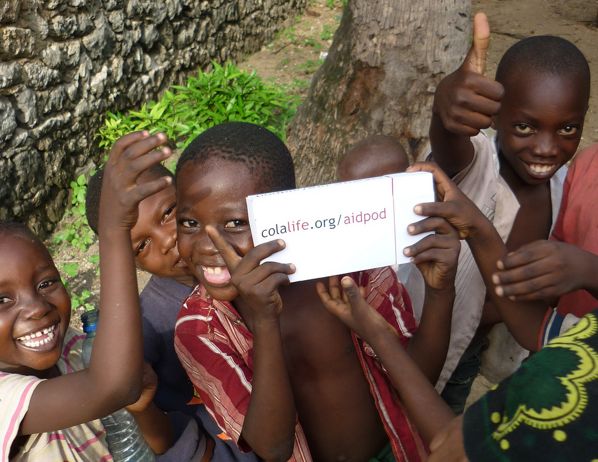
Simon Berry noticed while doing volunteer work in Zambia that no matter where he went, someone would always offer him a Coca-Cola. The village might be out of vaccines and basic medications we take for granted, but don’t worry, you could always get The Real Thing wherever you went. That got him to thinking: could Coke’s distribution prowess help save lives in rural Africa?
Looking into it further, he noticed that Coke shipped its product in trucks to larger cities and even some towns. But after that, the crates were distributed all over the country by a cottage industry of motorbikes, pack animals, and even handcarts. Since people made money distributing Coke, they took it everywhere they could. Berry thought that if he could just replace a few bottles in the crates, he could distribute medicines all over Zambia. Then his wife said that this wouldn’t sit well with Coke, because it ate into profits. But why not use the space between the bottles instead? Nobody was using that, and wherever the crates went, so did that unused space.
The resulting ColaLife AidPod is a waterproof plastic wedge that squeezes between bottles in Coca Cola shipping crates. Five pods fit in a standard crate, and carry oral rehydration salts and zinc supplements, along with soap, baby lotion, and other sundries. The package is made with PET plastic, so recipients can fill an AidPod with water and let the sun’s UV rays kill any waterborne bacteria (a process known as Solar Water Disinfection). This is critical because the medicine wouldn’t help much if people keep re-infecting themselves with unsanitary water.
Berry’s now working on viable business models, and developing a pilot program based on selling AidPods to new mothers, who may use or sell the products as needed. He’s assessing their ability to pay, knowing it won’t be a lot. But government subsidies could be injected at the national level, and this model has been successful with other aid programs. Coke is staying with the project so far, and the next steps are to launch the pilot and publish the findings.
You can visit the website at www.colalife.org, or watch this great video on TED.

Give a man a fish and he eats for a day. Teach a man to fish and he eats for a lifetime. Give him an International Harvester combine and he won’t catch or eat any fish.
Heifer International improves on the ‘fish for a day’ maxim by applying it to livestock and ecologically responsible farming. Since 1944, they’ve donated food animals to 12 million families in 125 countries. Livestock is a far better solution than farm equipment because livestock can provide power to pull plows, fertilizer to enrich the soil, eggs and milk to consume or sell, and wool to clothe and keep warm. Compare this to a single-use tractor requiring costly fuel and regular maintenance.
Recipients don’t pay for the donated animals, but must study animal husbandry and promise to ‘pass the gift on’. That is, at least one of the donated animal’s female offspring must be given to a neighbor, who must also study animal husbandry. That neighbor then repeats the cycle with another neighbor, resulting in a charitable effort that grows with each generation of livestock. So the gift multiplies as it… multiplies.
Heifer is creative in its fundraising options, too: it now offers a ‘wedding registry’, where couples sign up for gifts to Heifer International instead of the usual wedding presents. So bachelors, “buying the cow when you’re getting the milk for free” now buys a cow for someone who really needs it.
More information is available here and here, or you can watch a great video here. You can make a donation here.

Want to claim your tax refund in Hyderabad? That’ll cost you 10,000 rupees. Passed the driver’s test in Pakistan? You’ll have to slide 3,000 rupees under the table before holding your license. Your kid passed the entrance exams, but the school’s dragging its heels admitting him? That’s 20,000 shillings in Nairobi for a bureaucrat to do the job he’s already being paid to do.
In the developing world, corruption is seen as an unpleasant fact that ordinary people can’t change. Corruption robs a country of its productivity, discourages individual initiative, and lowers the general standard of living. Worse, according to Swati Ramanathan, co-founder of ipaidabribe.com, “(petty corruption) sets in motion a value system in a society which is very dangerous, because it compromises ethical conduct at an individual and personal level, to the point where citizens see beating the rules as something to be proud of.”
Fortunately, social media tools can help fight corruption: ipaidabribe.com collects and publishes anonymous reports of bribes paid, bribes requested, and payments that “were expected” as an unofficial cost of doing business in India. In just two years, the site has already received 400,000 reports, 80% of which concern government officials seeking illegal payments to perform routine services. To prevent lawsuits, ipaidabribe.com will not release any personal names or confidential information. But government departments are fair game, and the detailed reports are pretty damning, not to mention a PR nightmare for dirty bureaucracies. In fact, the site has become so popular that 17 other countries have inquired about licensing the source code to set up and run ipaidabribe sites of their own.
Sure, it’s just website, but the online reporting is driving offline change. For example, the Karnataka transport commissioner recently used ipaidabribe.com data to win support for reforms in the department of motor vehicles. 20 senior officers there were “cautioned,” and others received ethics counseling. Licenses are now applied for online, and all driving tests are now automated and videotaped, removing the personal interpretation that driving inspectors abused to line their pockets. ipaidabribe.com websites have a deterrent effect as well, especially as more information becomes public and site awareness increases.
Sources included this interesting Youtube video, this page and this page in the NYTimes, and the I Paid A Bribe website itself.
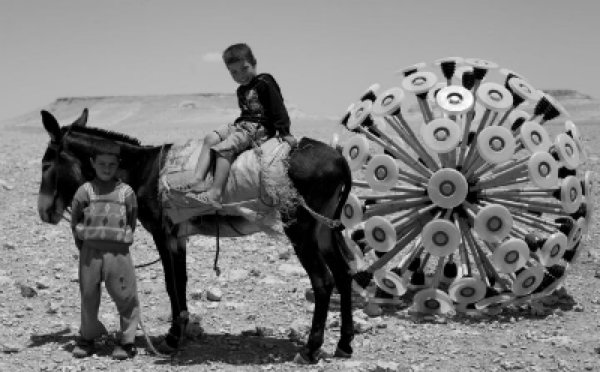
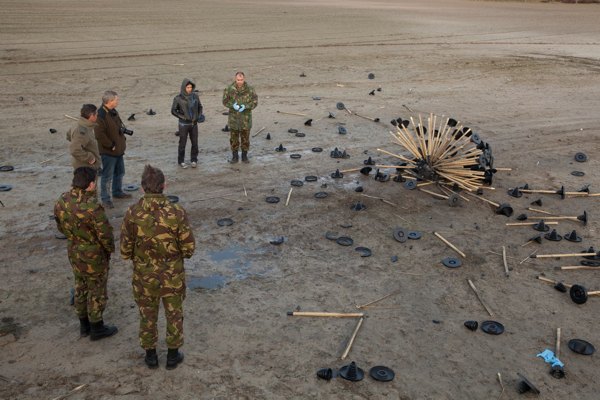
Massoud Hassani is a Dutch Afghan who grew up in the northern fringes of Kabul. As a boy, he and his friends would chase windblown toys across the desert, racing one another to see who could capture his toy the fastest. However, the games stopped whenever the toys blew too close to the airport, where landmines and unexploded ordnance from the Soviet war still littered the ground.
After his father’s murder in 1993, Hassani and his family moved to the Netherlands, where he became a design student. But he never forgot those days playing with his friends, and his graduation project from design school used the toy’s shape for the Mine Kafon, a low-cost, windblown landmine-decommissioning device.
Consider the Mine Kafon as an overgrown, battle-hardened dandelion. It’s a six-foot tall sphere with scores of bamboo poles radiating out from the core. Each pole terminates in a disc, which serves as a proxy for a human foot. The Mine Kafon is as heavy as a person, so when the wind blows and it rolls over a land mine, the mine detonates. It loses discs with each detonation, but can withstand four direct hits before needing repair. It even uses GPS so workers can identify which parts of a field haven’t been tested.
The $60 Mine Kafon falls short when compared to conventional mine clearing tools, which detect mines in a systematic fashion, clear vegetation, and step on each spot of ground twice. But you can’t ignore the economics: the Mine Kafon is 0.00012% the cost of NATO’s Aardvark mine-flailing vehicles. Hassani concedes the limitations of his design, but still thinks it’s an affordable way for villagers to inspect suspect areas prior to requesting NATO minesweepers.
Sources included Hassani’s blog and this article in the Atlantic. This Youtube video is long, but really good.
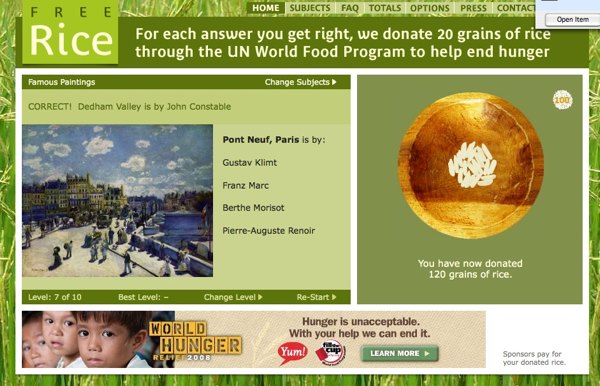
So, you’re a kid too young to work, and your parents keep harping on you to study more. How can you improve life in the developing world?
What you need is a means to help that’s more appropriate to your situation. Well, if you’re reading this, you’re probably online and have a working mouse. Here’s your chance to feed the hungry while feeding your brain.
In 2007, John Breen donated the FreeRice.com website to the United Nations World Food Program. Its goal is to provide free education and famine relief at the same time. Kids play an online English vocabulary quiz, and grains of rice are donated for each correct answer (1 correct = 10 grains of rice, 5 correct = 50, etc.). The questions get harder over time, and incorrect answers are repeated or replaced with easier questions. Additional subjects include foreign languages, literature, geography, math, and chemistry.
Why not just give the rice away? Because Freerice.com doesn’t have it. Players earn the rice via sponsor banners that appear every time a correct answer is made. The money generated by these banners is then used to purchase rice for famine relief. Oh, advertising – is there nothing you can’t do?
As of this writing, all rice earned on Freerice.com is being distributed to Haiti, but prior winnings have also been distributed to Bangladesh, Cambodia, Uganda, Nepal, Bhutan, and Myanmar.
Sources included this FAQ and this interesting video. Donations can be made here
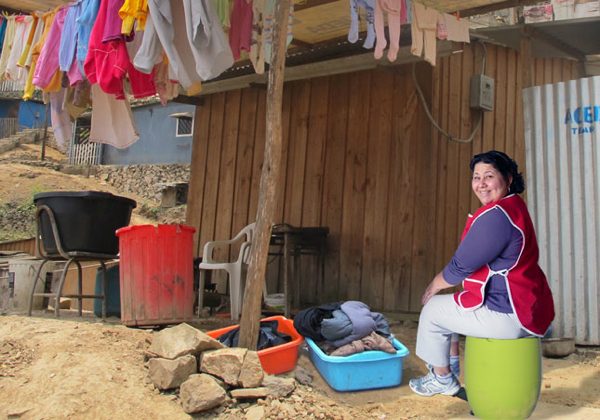
Families in rural Peru live on $4-10 a day. For women in these families, clean clothes are both a matter of family health and dignity. There is no electricity, so all laundry must be done by hand, and takes about six hours. It’s an enormous investment of time and effort, exposing the women to tenosynovitis, chronic lower back and hand pain, and respiratory illnesses. Oh, and they have to do it 3-5 times a week.
So Giradora introduced a human-powered washer and spin dryer. The user inserts the clothes into the drum and then sits on the lid while operating a foot pump. The pump operates the washer’s agitator and later spins the clothes until they’re nearly dry, greatly reducing clothesline time. This is critical in Peru, where wet clothes can take 3 weeks to dry in winter, and mold grows easily in those conditions. The solution is also far more ergonomic, and saves time because it washes clothes by the load instead of by individual item. Giradora even claims the product can provide “income opportunities for women through laundry services, renting, or direct sales.”
The washer sells for $40, which is 1/5 the cost of the cheapest spin dryer on the market. But the best part is that these poor women finally get to sit down for a change.
Sources included this Youtube video and this article.
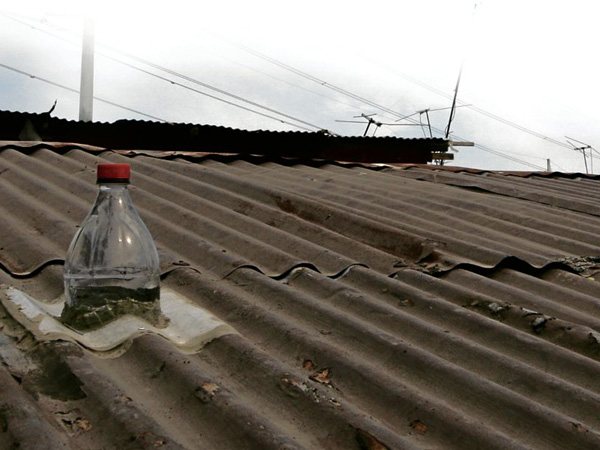
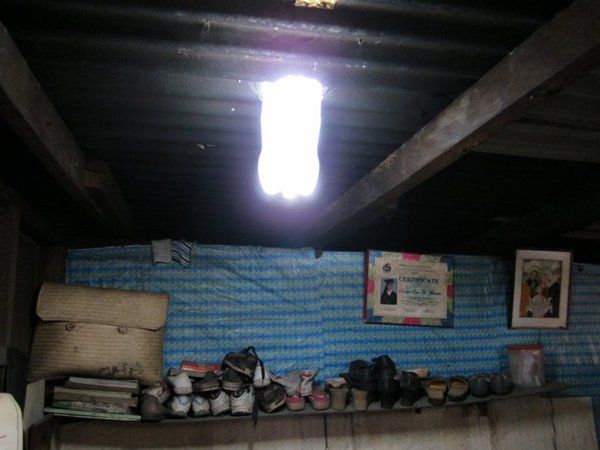
Why did man first harness fire? Was it the heat, the way it cooked food, or because “chicks dig guys who stand near flames”? Well, all that, but mainly it was because fire banished the dark. Man was no longer prisoner to night: nocturnal predators were held at bay, and the amount of work that could be completed in a day increased.
Cut to today. Homes in the dense shantytowns of Manila have no electricity. Worse, they are built so closely together there are no windows or sources of natural light. As a result, the interior of most homes is too dim to do much of anything, even in midday. Families work, do chores, and eat together in near-total darkness. Economically and ecologically sustainable lighting is sorely needed.
Amy Smith and a bunch of MIT students attacked this same problem while working in Haiti, and came up with the Solar Bottle Bulb, a solution as ingenious as it is simple. The bulb consists of a one liter plastic bottle filled with water and a few teaspoons of bleach. The bottle is fixed into the roof and acts as a kind of skylight. But unlike a skylight, which only admits light downward in a straight line, a Solar Bottle Bulb refracts and spreads sunlight in 360 degrees, lighting all parts of the room below. The effect is quite dramatic, equivalent to a 60-watt electric light bulb. Better still, the Solar Bottle Bulb is easy to install and uses readily available materials. A single bulb lasts about five years.
After seeing YouTube videos of the Solar Bottle Bulb at work in Haiti, Iliac Diaz brought the concept to Manila via A Liter of Light, a non-profit foundation working with local governments. They sell Solar Bottle Bulbs for $1 apiece, and have installed 12,000 bulbs lighting 10,000 homes. Diaz says, “Once people see the benefits to the community, they will grab the technology. It will spread like a drop of ink.”
Sources included this video, and articles here and here. Donations can be made here.
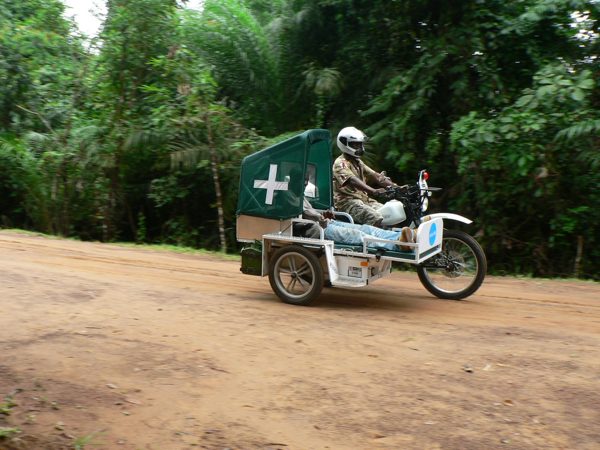
According to British engineer Mike Norman, “Donated ambulances (from the West) won’t do 100 yards in Africa.” And conventional 4X4 vehicles are sprung so tightly the journey to the hospital would be more hazardous than the patient’s original emergency. This is especially true for expecting mothers in rural Africa, where complications in childbirth, coupled with the lack of nearby medical care, contribute to sky-high maternal mortality rates.
So Necessity calls her kid Invention in from the garden, and sets it to work on the problem. The result is Norman’s eRanger ambulance, a highly maneuverable off-road motorcycle with a sidecar stretcher for the patient. The design combines the benefits of a motorcycle with the cargo capacity of a sidecar, in a package that is cost effective (only $6200), rugged, and simple to maintain.
Substantial damping and suspension work smoothes the ride over rough ground, and crude as it may appear, the eRanger delivers patients to faraway hospitals much more safely than other types of vehicles. In fact, one district in Malawi reported a 60% decline in maternal mortality rates since introducing the eRanger in 2003. eRangers can now be found in 17 African nations, and pilot projects are starting in Afghanistan and Haiti.
Sources included this Youtube video and
this article, as well as the eRanger website itself.
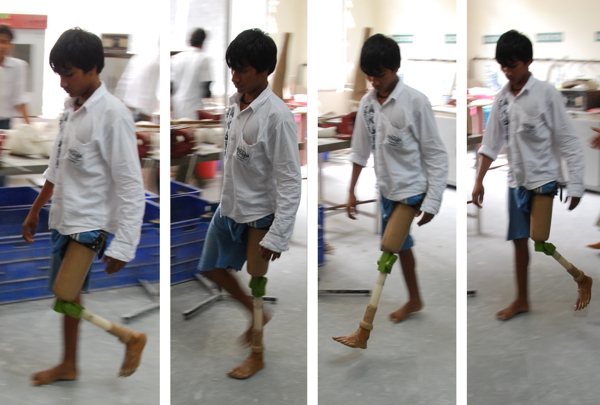
If you don’t get a lump in your throat watching an adult amputee climbing a tree like a nine year old, you’re just not human.
The Jaipur Foot is a hard rubber prosthetic leg for people with below-knee amputations, typically victims of landmine explosions. It was produced by Ramchander Sharma, under the guidance of Dr. P.K. Sethi in 1969. Mr. Sharma thought of the idea while riding his bicycle, noting how tough the rubber tires were. Then he got to thinking about how a foot made out of hard rubber could help amputees walk more naturally. What he wanted was a prosthetic that was easy and cheap to make, rugged, waterproof, and which could imitate the performance of the lower human leg as much as possible.
Using hard rubber solved many of these issues, and the material especially excelled in providing the user with a more natural range of motion. And not just for walking, but squatting, standing from a sitting position, and even running. It’s so natural to use that most wearers return to their previous jobs after receiving a Jaipur foot. The entire prosthetic costs $28, lasts five years, and thousands of India’s poor have received one. The Jaipur Foot earned Dr. Sethi the Padma Siri award from the Indian government, and TIME magazine honored it as one of its “50 Best Inventions” in 2009.
Sources included this fantastic Youtube video, the Jaipur Foot Wikipedia page, and the Jaipur Foot website. Donations can be made here.
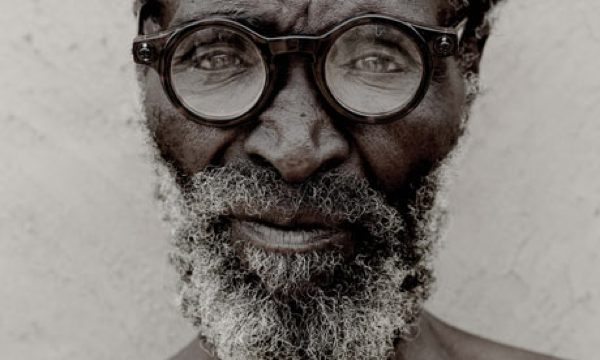
Eyeglasses are relatively cheap and plentiful. However, in the developing world, what is not plentiful is the expertise to configure lenses to the wearer’s individual vision. In sub-Saharan Africa there is about one optometrist for every million people, and in some countries that number balloons up to one optometrist for every eight million people. So the vision care model we have in the developed world simply won’t work in the developing world. Makes you want to slap those hipsters wearing non-prescription lenses, doesn’t it?
Enter Josh Silver, who has created practical, self-adjustable, liquid-filled eyeglasses. Increasing or decreasing the amount of fluid in the lenses creates the needed refraction to achieve proper vision. The glasses are rugged, ultra low-cost, and most importantly, enable the patient to self-adjust the fluid level until correct sight is achieved in each eye. The process to self-configure a pair of functioning prescription lenses takes less than a minute, and to date over 40,000 eyeglasses have been distributed around the world.
Dow Corning learned of Silver’s glasses and committed $3 million of funding and materials expertise to the ChildVision initiative, a humanitarian project that will design, manufacture, and distribute child-specific versions of Silver’s design to kids in the developing world. Dow Corning believes that in addition to improving a child’s vision, the glasses will also improve their access to education, since “many methods of education can be visually demanding, and if children can’t see the board from which they are being taught, then that’s going to have a significant impact on their educational capability.”
Sources included Josh Silver’s Ted Talk, and pages here, here, here and here. This Youtube demo video is really good.


